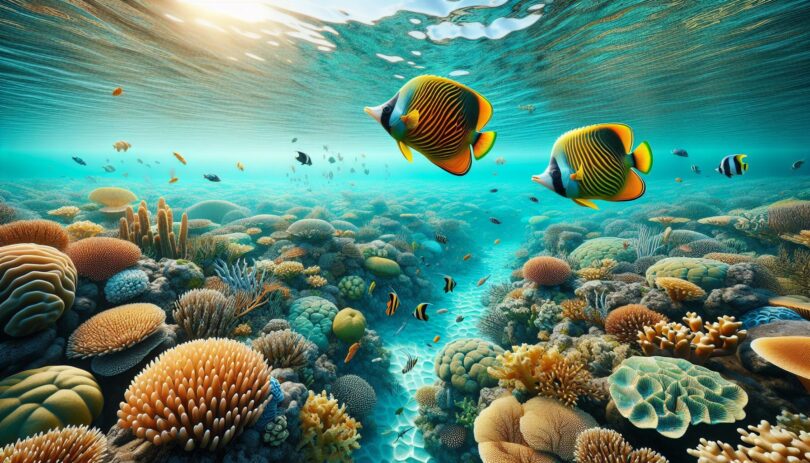Is a blue tang a saltwater fish? You bet it is, and it’s one of the most captivating creatures you’ll find in the marine world. Known for their vibrant blue color and distinctive shape, blue tangs have captured the hearts of fish enthusiasts and ocean lovers alike.
I’ve always been fascinated by the variety of life in our oceans, and the blue tang stands out as a particularly intriguing species. Not only are they a marvel to behold in their natural habitat, but they also play a crucial role in the ecosystem. Let’s dive into the world of the blue tang and discover what makes them such a remarkable saltwater fish.
Blue Tang: A Saltwater Fish
Embarking on the journey of setting up an aquarium, one must understand the pivotal distinction between freshwater and saltwater fish. My fascination with the vibrant underwater realm led me to the blue tang, a gem of the saltwater ecosystem. Known for its striking blue hue, the blue tang is indeed a saltwater fish, requiring specific conditions that mirror the ocean’s complexity.
When planning your aquarium, especially if you’re enamored by the captivating beauty of the blue tang, several considerations come into play. Aquarium tank size is paramount. These active swimmers demand ample space to roam, so I always recommend a tank size of at least 100 gallons for their well-being and to emulate their natural habitat accurately.
Equally crucial is the aquarium setup. Saltwater aquariums pose a unique challenge, often necessitating more sophisticated aquarium equipment. For instance, a robust fish tank filter and an effective aquarium heater are non-negotiables to maintain the pristine water conditions blue tangs thrive in. Adding to that, an aquarium light simulating the natural spectrum of sunlight not only highlights the blue tang’s mesmerizing color but also supports any live plants or corals in the aquarium.
Furthermore, water quality cannot be overlooked. I always use a high-quality water conditioner for fish tank setups to ensure the removal of harmful chemicals from tap water, making it safe for my saltwater community. It’s crucial for the health of blue tangs, as they are sensitive to fluctuations in water conditions.
Embarking on the journey to include a blue tang in your saltwater aquarium is not only about admiring its beauty but also committing to the specific care requirements these magnificent creatures need. By understanding and respecting their needs, we create a thriving environment for them and a mesmerizing spectacle for us.
The Captivating Beauty of the Blue Tang
When I first started my aquarium, the one species that truly caught my eye was the blue tang. Known for its vivid blue body and striking yellow tail, this saltwater fish is a showstopper in any marine setup. Far from being just another fish in the tank, the blue tang brings a dynamic energy and aesthetic appeal that’s hard to match.
Maintaining the Perfect Environment for the blue tang isn’t a walk in the park, but it’s absolutely worth it. These fish require a specific set of conditions to thrive, including a large tank. Ideally, an aquarium tank size of at least 100 gallons is recommended to provide ample swimming space. This might seem like a lot, especially if you’re just starting your aquarium, but giving these magnificent creatures the room they need is crucial for their wellbeing.
Another key aspect of their care involves the aquarium setup. Saltwater fish like the blue tang require clean, well-oxygenated water to stay healthy. This means investing in quality aquarium equipment is non-negotiable. A powerful fish tank filter is essential for maintaining water purity, alongside an aquarium heater to keep the water temperature stable. Aquarium lights also play a significant role by simulating the natural light cycles of the blue tang’s ocean habitat. Lastly, using a water conditioner for fish tank ensures the water is safe and comfortable for them to live in.
My journey with the blue tang has taught me that while setting up and maintaining their environment may seem daunting at first, witnessing their beauty and grace in your own aquarium is incredibly rewarding. The blue tang isn’t just another saltwater fish; it’s an aquatic jewel that enhances the allure of any marine aquarium. Watching them glide through the water with effortless elegance, it’s clear that the effort put into their care is a small price to pay for the beauty they bring into our homes.
The Distinctive Features of the Blue Tang
When I first embarked on my aquatic adventure, diving into the world of saltwater fish, the blue tang stood out as a marvel of the ocean’s depths, captivating me with its vibrant hues and graceful movements. Known scientifically as Paracanthurus hepatus, this saltwater species boasts some truly unique characteristics that set it apart from other marine life, and here’s why they’ve become a focal point in many aquarium setups.
One of the most striking features of the blue tang is its vibrant blue color, complemented by a striking yellow tail that seems to glow under the right aquarium light. This vivid coloration isn’t just for show; it plays a crucial role in their natural habitat for both camouflage and communication with other marine life. It’s their color that often draws enthusiasts to add them to their saltwater aquariums, emphasizing the importance of proper aquarium setup to maintain the intensity of their hues.
Moreover, blue tangs have a distinctive shape characterized by a flattened body and a sharp, scalpel-like spine on either side of the caudal peduncle. This spine serves as a defense mechanism, making it essential for owners to handle them with care during tank maintenance and when starting your aquarium. Their unique body shape and size also mean that when considering aquarium tank size, one should aim for at least 100 gallons to provide ample swimming space for these active swimmers.
Another aspect that fascinates me is their diet and feeding behavior. Blue tangs are primarily herbivores, which means they require a diet rich in marine algae. Ensuring their dietary needs are met is critical for their overall health and wellbeing in an aquarium setting. This includes maintaining high-quality water conditions, for which I’ve found that using a water conditioner for fish tanks is indispensable. It helps remove harmful chemicals from tap water, creating a safer environment for these sensitive creatures.
In terms of aquarium equipment, integrating a fish tank filter, aquarium heater, and dedicated aquarium lighting is non-negotiable to mimic their natural habitat as closely as possible. The filter keeps the water clean and well-oxygenated, the heater maintains the ideal temperature, and the light showcases their brilliant colors, all of which contribute to the thriving life of a blue tang in captivity.
The Role of Blue Tang in the Ecosystem
When I delve into the intricacies of the marine ecosystem, I’m always fascinated by how each species, no matter how big or small, plays a pivotal role in maintaining the balance. The blue tang, a remarkable saltwater fish, is no exception. Its role in the ecosystem is both fascinating and crucial. One can’t help but marvel at the beauty and significance of these creatures beyond their striking blue color.
Firstly, it’s important to recognize the blue tang’s contribution to coral health. They’re voracious grazers of algae, which, if left unchecked, can overwhelm and suffocate coral reefs. By controlling the algae population, blue tangs ensure that coral reefs remain healthy and can continue to provide vital habitats for thousands of marine species. This interaction underscores the interdependence between different species within the marine ecosystem.
Moreover, blue tangs themselves are a source of nourishment for a variety of predators. From larger fish to seabirds, the blue tang is an integral part of the food web. Their presence and population dynamics can greatly influence the predatory patterns and population health of other marine animals.
In addition to their biological roles, blue tangs contribute to the nutrient cycle within their habitats. As they feed and move across the reef, they help in distributing nutrients, which is essential for the overall productivity of the marine environment. This aspect of their behavior highlights the complexity of marine ecosystems and the need for careful aquarium setup for hobbyists aiming to replicate these natural processes.
For those starting their aquarium, especially a saltwater tank, understanding the ecological value of blue tangs can inspire a more profound appreciation and commitment to maintaining their well-being. Incorporating elements like a fish tank filter, aquarium heater, and aquarium light can help replicate their natural habitat. Additionally, using water conditioner for fish tank ensures the water quality is conducive to sustaining a mini-ecosystem that mirrors the intricate balance of the ocean’s coral reefs.
The interconnectedness of marine life is a fascinating tapestry, with the blue tang playing its unique and vital role. It’s a reminder of why maintaining biodiversity is crucial, not just in the wild but also in our home aquariums. As we continue to explore and understand these relationships, we can better appreciate the complexity and beauty of marine ecosystems.
Conclusion
Embarking on the journey of caring for a blue tang is an enriching experience that rewards with more than just a stunning visual spectacle. It’s a commitment to understanding and replicating the complex ecosystems that these vibrant creatures inhabit. By investing in the right tank size, quality equipment, and maintaining pristine water conditions, I’ve learned that the thriving health of blue tangs is achievable. Their role in the ecosystem, from contributing to coral health to being a part of the nutrient cycle, underscores the importance of meticulous care in their aquarium setup. It’s not just about the beauty they add to our homes but also about respecting and preserving the natural balance they represent. My experience has taught me that with dedication and the right knowledge, maintaining a blue tang’s environment is not just rewarding but a step closer to understanding the intricate beauty of marine life.



